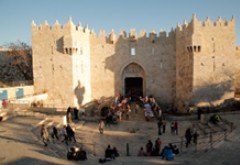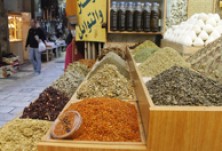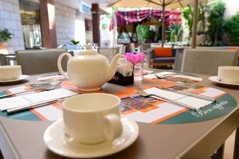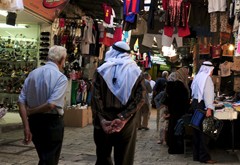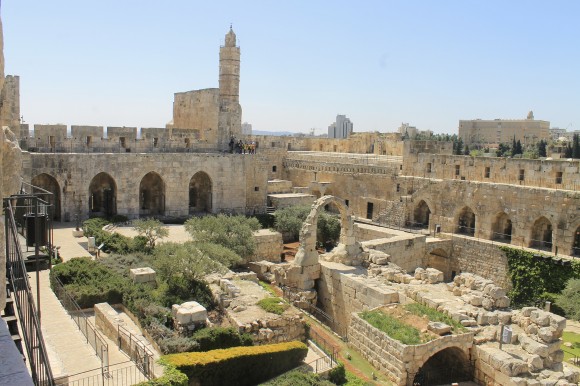(Entrance fee applicable. Open daily 8:00 a.m. - 5:00 p.m.)
Position
One of the most prominent features of Jerusalem, the Citadel is located in the western part of the Jerusalem Wall, near Bab al-Khalil to the south. The Citadel is a model of Islamic military architecture. It was built in a strategic location to defend the western entrance of the Old City, and the selection of this site was directly influenced by the presence of fortifications dating back to past eras. As it stands today, the Citadel dates back to the era of Sultan Nasir Muhammad Ibn Qalawun, who ordered its reconstruction in 1310 AD (710 H), according to a foundation inscription that was located over the main entrance and recorded by Swiss epigraphist r Max van Berchem in 1894, but which has since disappeared. Historian al-Qalqashandi also mentioned that Sultan Nasir Muhammad Ibn Qalawun had ordered the renovation of the citadel in 1316 AD (716 H). The Citadel constituted a central military site in Jerusalem where the city’s protection garrison, led by the Citadel’s commander, was positioned, as well as headquarters for the Mamluk administration in the city. British archaeologist Jones, who carried out excavations in the site in the 1930s and 1940s, concluded that the outer wall of the Citadel, including the towers, forms a single architectural unit dating back to the early Mamluk era. This style of architecture can be seen in many of the contemporary Mamluk citadels, especially in Jordan, such as Karak and Shobak Castles. Nevertheless, the building contains sections from the earlier Hellenistic, Roman and Islamic eras, as well as other sections from the late Ottoman era.
Layout
The Citadel offers a non-homogenous, rectangular shape, comprising high walls and five high towers, surrounded by outer fortifications and a moat. The Citadel is accessed from the outer eastern gate, added by Ottoman Sultan Suleiman I (Suleiman al-Qanuni) in 1532 AD / 939 H, leading to a wooden bridge over the outer moat, then to defense fortifications, and finally over a stone bridge and an inner moat to the main inner gate. The gate’s entrance is topped by a stone filling that most likely contained the missing foundation inscription. The entrance leans to the right and then to the left, leading to a vaulted octagonal room with a ventilation window. Inside this room, a stone staircase leads to the roof of the northeastern tower, known as the Tower of David, which is presumably dated back to Herod’s reign in the 1st Century B.C. From the top of the tower, the view of the Old City is captivating, especially the Dome of the Rock.
Development
Archeological excavations in the courtyard of the Citadel revealed part of a wall and two huge square towers dating back to the period between the 2nd and 1st centuries BC, as well as a circular tower and part of a wall that appear to belong to the first citadel that was established here during the Umayyad era. The hallway of the upper floor of the southwestern tower was turned into a mosque in the era of Sultan Suleiman al-Qanuni in 1531-1532 AD / 938 H, and includes a beautiful niche (mihrab) and pulpet (minbar). On the eastern wall of this mosque, two foundation inscriptions can be seen, but not in their original locations. The first inscription speaks of the construction of a tower in the Citadel by the Ayyubid King al-Mu’azam Isa in 1213-1214 AD / 610 H, while the second speaks of the construction of a mosque by Sultan Nasir Muhammad Ibn Qalawun when he ordered the reconstruction of the Citadel in 1310 AD / 710 H. The mosque’s minaret was added in 1655 AD / 1065 H.
Bab al-Khalil provides a beautiful view of one of the valleys surrounding the Old City, namely, the Western or al-Rababa valley, as well as a large part of West Jerusalem. Seeing the western part of the Jerusalem Wall and the Prophet David Mount in the background is worthwhile. To continue the Wall trail requires leaving Jaffa Gate from the outside and walking north along the pedestrian walkway adjacent to the paved road, reaching the northwestern corner of the Jerusalem Wall, where the College Des Frères and the Tankrid Tower from the Franks era. Turning east and walking a few meters along the road takes us to Bab al-Jadid, the last station of the Jerusalem Wall trail.

